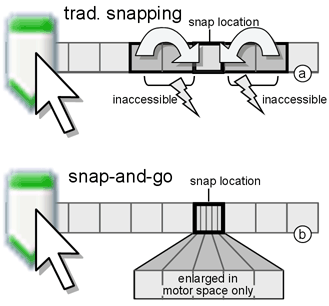snap-and-go
|
up patrick baudisch |
| snap-and-go try it out (demo)! user study 1D user study 2D |
Snapping is a widely used technique that helps users position graphical objects precisely, e.g., to align them with a grid or other graphical objects. Unfortunately, whenever users want to position a dragged object close to such an aligned location, they first need to deactivate snapping. We propose snap-and-go, a snapping technique that overcomes this limitation. By merely stopping dragged objects at aligned positions, rather than “warping” them there, snap-and-go helps users align objects, yet still allows placing dragged objects anywhere else. While this approach of inserting additional motor space renders snap-and-go slightly slower than traditional snapping, snap-and-go simplifies the user interface by eliminating the need for a deactivation option and thereby allows introducing snapping to application scenarios where traditional snapping is inapplicable. In our user studies, participants were able to align objects up to 138% (1D) and 231% (2D) faster with snap-and-go than without and snap-and-go proved robust against the presence of distracting snap targets.
|
|
Baudisch, P., Cutrell, E., Hinckley,
K., and Eversole, A. |
